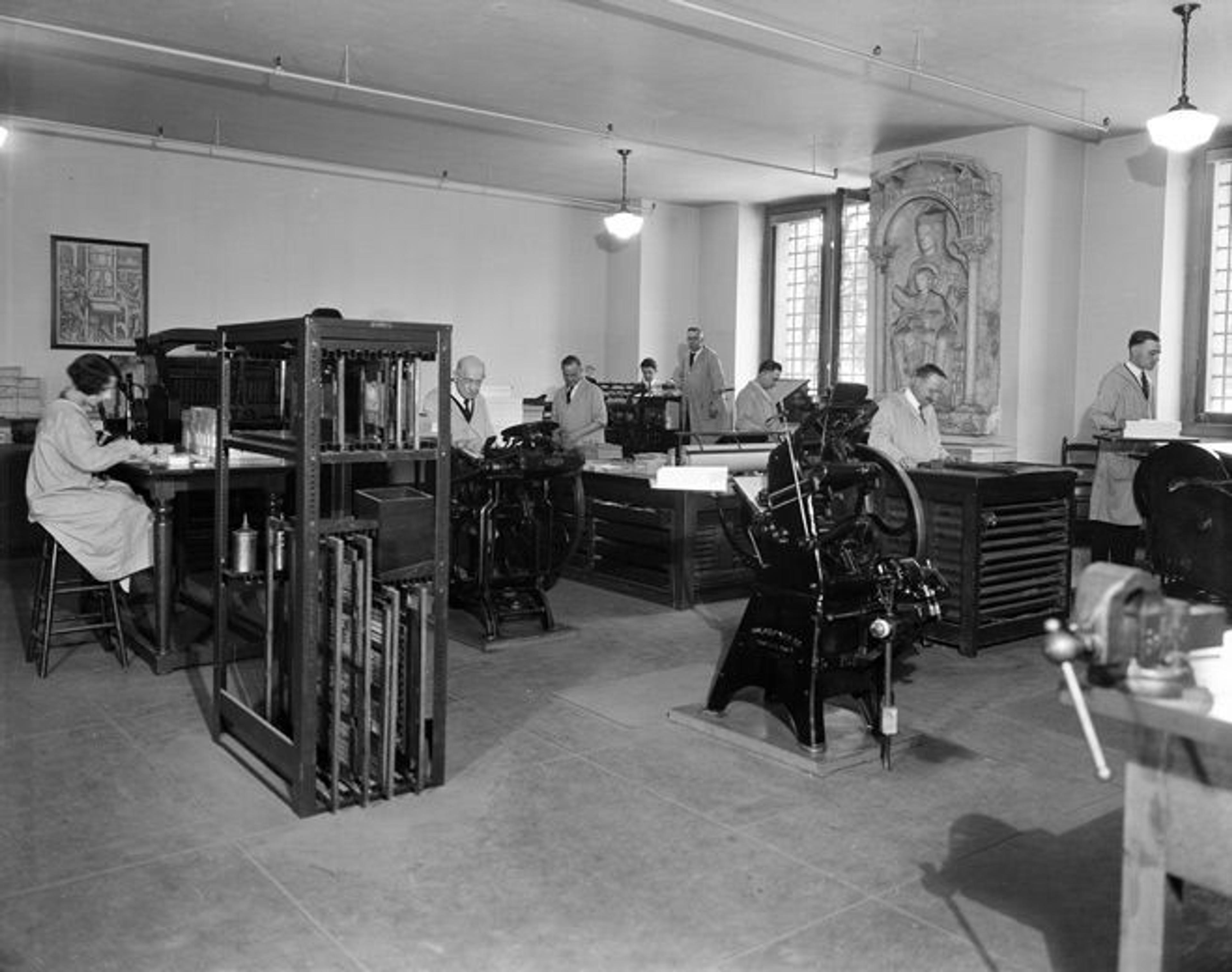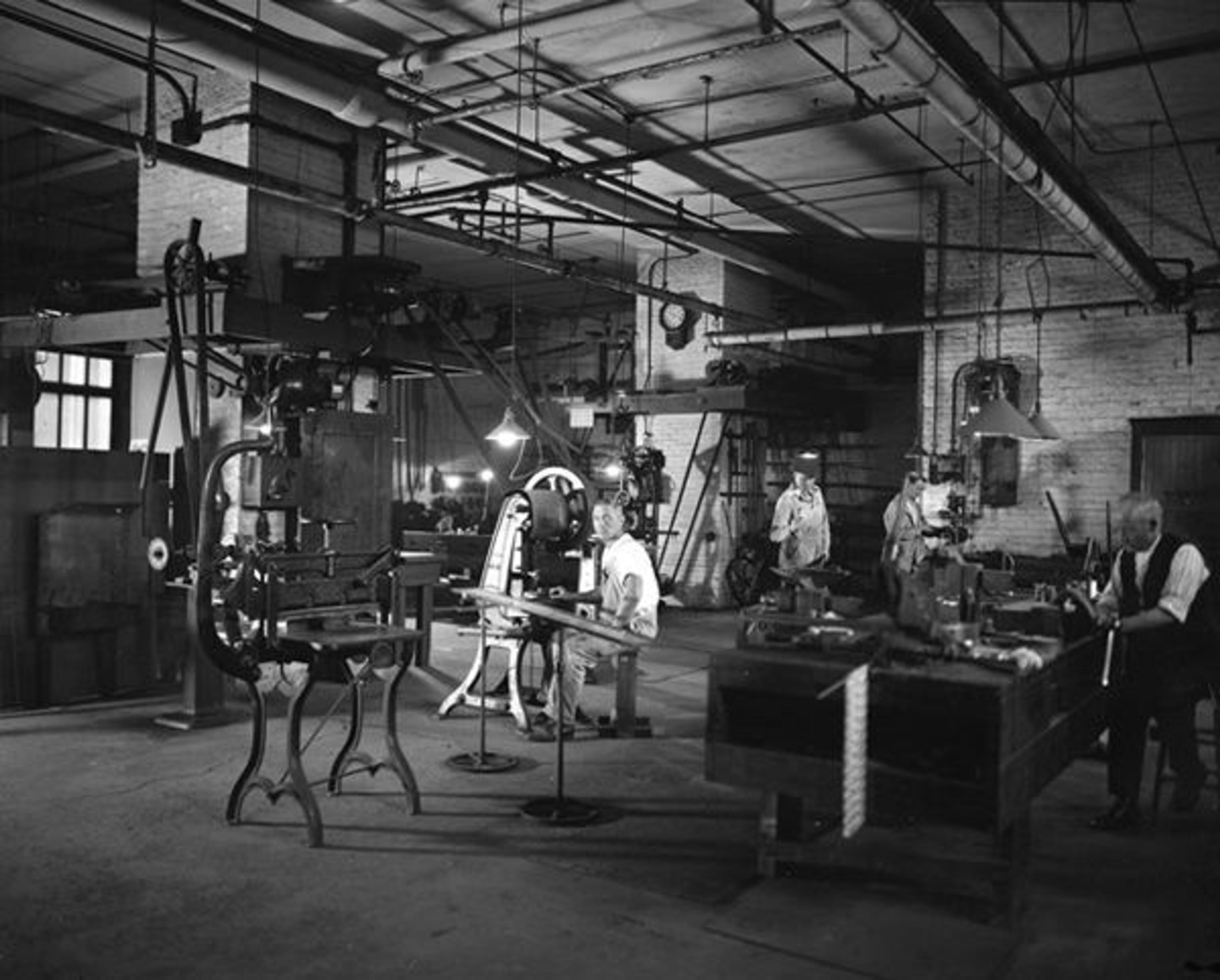
The Metropolitan Museum of Art, Printing Shop: The Printing Press Office; View facing southeast. Photographed June 2, 1926. See slideshow
«Hidden behind the galleries, unseen by visitors, lies a veritable city within the Museum's walls. In support of the Met's buildings and daily activities are highly skilled, highly dedicated tradesmen, and our many workshops see the tireless work of carpenters, engineers, lampers, painters, plexi-workers, plumbers, riggers, roofers, landscapers, electricians, machinists/millwrights, and locksmiths. The product of their work is knowable by the constant fine-tuning of our galleries and buildings, and by the comfort of visitors and employees who spend their days at the Museum. Their work has gone on without much fanfare, but without their expert efforts the Museum would struggle to subsist.»
In 1906, the office of Superintendent of the Building was created for Mr. Conrad Hewitt, "a graduate of Princeton University, with experience both as an engineer and an architect" (Annual Report of the Trustees of the Metropolitan Museum of Art, No. 37 [1906], 20). He was charged with "relieving the Director and Assistant Director of many of the burdens connected with the management of the building" (Ibid.). During his first year he made many notable, necessary, and important changes for the preservation and safety of the Museum's collection, the convenience of the public, and the Museum's employees. The Annual Report of 1906 lists the following improvements:
New grates, with a system of balanced draught, have been installed in the boilers, and are expected to effect a large saving in the amount and cost of fuel consumed.
The freight-elevator power has been changed from steam to electricity.
The carpenter's shop has been equipped with modern machinery.
New windows have been cut in the Library and in the Treasurer's office, thus giving greatly needed light and ventilation for the clerical force.
[. . .]
A fireproof storeroom has been built in the place of the old wooden one, and a fireproof vault provided for the Registrar.
Metal lockers are being installed for the attendants instead of the old wooden and plaster closets.
Attention has been given to increased fire protection, fourteen hundred and fifty feet of fire hose and thirteen fire extinguishers have been added to our equipment.
[. . .]
A roofer has been engaged to take the permanent care of the roof, and icicle guards have been built along the roof over the galleries (Annual Report of the Trustees of the Metropolitan Museum of Art, No. 37 [1906], 22–23).

The Metropolitan Museum of Art, Metal Shop. Photographed September 21, 1922
Throughout the 1910s and '20s, the Museum's workshops continued to receive mentions in both the Annual Report and Bulletin. In 1912, "A new Boiler House is under construction at the present time and also a wing for the carpenter and paint shops . . ." "During the year the Museum has equipped a shop for the manufacture of metal-frame exhibition cases, so that hereafter all new exhibition cases used in the Museum can be manufactured on the premises" (Annual Report of the Trustees of the Metropolitan Museum of Art, No. 43 [1912], 36).
Also in 1912, on Wednesday, June 12, The American Association of Museum's seventh annual meeting was held at the Museum. After the welcome address, a program of papers read, and luncheon, the Association members were given the opportunity to visit "the photograph department [of the Library], the workroom of the repairer of tapestries, the repair shop, the printing office, and the shop of the armorer" (The Metropolitan Museum of Art Bulletin, Vol. 7, Jul. 1912, 138).
In 1926 (the same year the Museum purchased The Cloisters): "In no year has the work of the Museum made such demands upon the skill, interest, and energies of the Staff, including shop-men and attendants, as in the one just ended . . ." (Annual Report of the Trustees of the Metropolitan Museum of Art, No. 57 [1926], 4).
The Museum also invested a tremendous amount of talent in presenting its collection. In the Printing Shop, there were printers and photographers who were kept perennially busy, such as in 1916 when "11,840 labels were printed by the Museum printer, and in addition, 963 labels were lettered by hand. Many objects have been repaired and a large number mounted . . ." (Annual Report of the Trustees of the Metropolitan Museum of Art, No. 47 [1916], 12). The work formerly done by the Lettering Shop is now the responsibility of the Design Department, which oversees all elements of permanent and exhibition installations, including exhibition-installation design, large- and small-scale wall texts, posters, invitations, and promotional materials.
Related Link
View a slideshow of archival images related to this post.